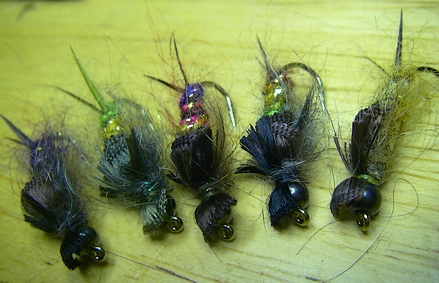Per the request to see a close up of these colorful oddities, I’ve included the top and bottom view.
The bottom shows the color gradient the yarn induces, and the top view shows the different colors of Bernat Boa wingcases added. Most used Brown, Black, or Olive – but I used golden brown on the Golden Mutt.

Both Bernat Boa and Moonlight Mohair change colors every couple of inches – which is the entire point to using them. Naturals have a multitude of colors or striations, only not as radical as what the yarn does.

None of this matters, add the six or seven shades darker the fly will be when wet, and how water depth filters color – in shallow water red is still red, but below 8 feet, red is no longer red. The fly will appear different than seen in normal light – that’s for certain.
The resolution of the above does not show the sparkle dubbing component I blended for each fly and used under the wingcases.

Again, I gotta say those are so damn cool. Nice flies. Feel free to send me all you want. : )
i think we need a step by step….
I can do that, I’ll put it on the Singlebarbed fly tying site this weekend. It’s going to be raining all weekend anyways.
http://singlebarbed.wordpress.com/
K – do you know of any studies that have been done on fly color, light filtration in the water, time of day, and its effect on fish (specifically trout)?
Most of the work I’ve seen is saltwater – the ocean is deeper, allowing the tests to cover the full color spectrum. None of the studies I’ve seen mention flies – they’re all using colors on a board or something similar.
Different fish have different ocular capabilities so there’s no study that’s all encompassing. Plenty of studies on trout eyeballs, the hard part is the translation from latin… scholary work is difficult to read unless you have a background in Science.
I can’t lie I want to put one of those in my mouth and pull it through my lip just to know what it feels like to eat one and get hooked.